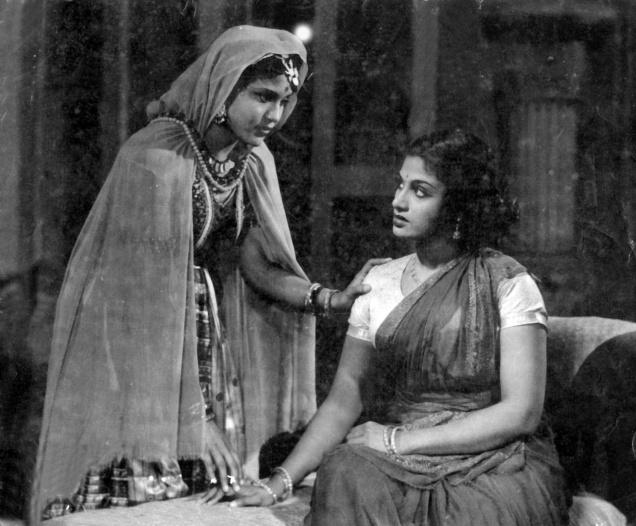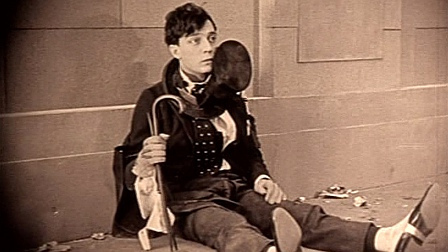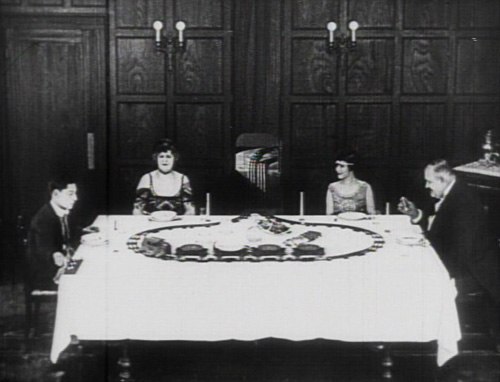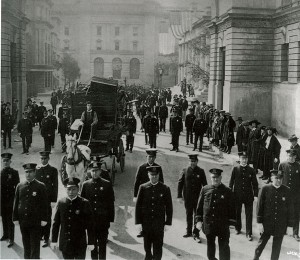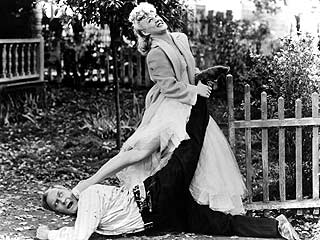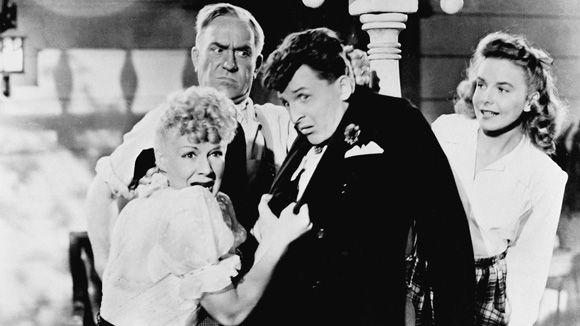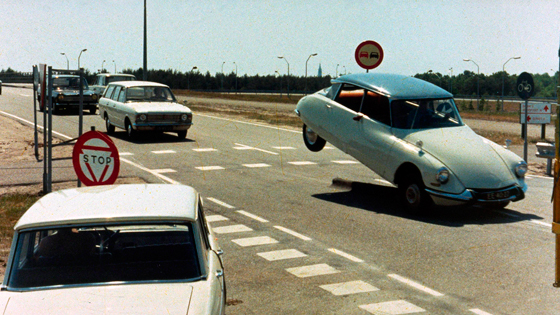From the Soho News (August 20, 1981). — J.R.
Film India: Indian Film Festival Museum of Modern Art, through August 23
Buster Keaton Film Festival Lincoln Plaza, through September 19
Directed for Comedy Regency, through October 17
Honky Tonk Freeway Written by Edward Clinton
Directed by John Schlesinger, opens August 21
AUGUST 7: The first movie I see for this column isn’t a light comedy, but it sure puts me in a sunny mood. The prospect of a three-hour Indian film in Temil with no subtitles is a little off-putting, I would say -– wouldn’t you? On my way into the sparsely populated auditorium of the Museum of Modern Art this afternoon, I hear not one but two separate senior citizens crack jokes about what a nice opportunity this is for a nap.
And yet, just as Indian film buff Elliott Stein has predicted, I have surprisingly little trouble following the plot and action of Chandralakha (1948). The quaintly illusionistic charm of a black-and-white movie like this, about a good and bad brother vying for the throne in a mythical kingdom – with a large palace protected by a drawbridge –- is part of its primal pull from the beginning.
I’m struck, for instance, by the carefree crosscutting in the opening sequence between the hefty hero in exterior locations, participating in a robust Northwest Mounted Police sort of song, and the heroine he suddenly meets in front of a gorgeously painted backdrop -– as if the two were totally continuous (or at least contiguous) spatial realities. Afterwards, she wanders off into an artificial bucolic set reminiscent of Curse of the Cat People, sniffing flower petals on a tree while belting out a happy song in a manner worthy of Jane Powell.
Some of Chandralakha has the lurid look of a Flash Gordon serial (although, mutatis mutandis, so does Eisenstein’s Ivan the Terrible, when you think about it), and the movie’s often a string of deconstructive technical oddities that summon up such unorthodox and alienated Western filmmaking spirits as Oscar Micheaux and Edward D. Wood, Jr. (e.g., when a conspirator whispers to the young, wavy-haired hero, the soundtrack abruptly reverts to a parch of dead silence à la Godard’s Band of Outsiders.) Battle scenes are edited so fast that you can barely tell what’s happening, but then the film stretches out into longer, more leisurely takes for the spirited songs.
Before long, we learn that the hero and heroine are called Baba and Chandra, respectively; and when Chandra encounters a traveling circus, things pick up considerably. A comic dressed in a bear suit scares and fools practically everyone; some of the “300 Gemini girls” announced in the credits perform vigorous calisthenics under the Big Top; and a protracted nonnarrative display of acrobatics temporarily turns the movie into a version of the Ed Sullivan Show. Lions, tigers, goats, camels, and elephants eventually get into the act, too –- as well as the actors, who have a strong, silent-movie sense of how to do a lot carnally with their eyes.
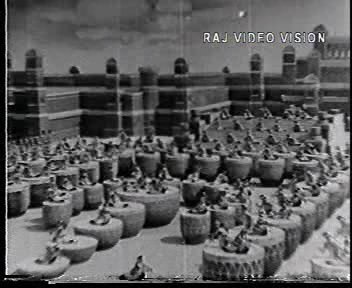
But all these amusements are a mere prelude to the grand Quo Vadis of outdoor musical numbers toward the end –- reeking of Esther Williams and/or Leni Riefenstahl, though it also suggests Fritz Lang’s Die Nibelungen restaged by Busby Berkeley. Scores of women dance on majestic steps and on the tops of 72 (by my rough count) gigantic conga drums, which turn out to be holding the members of an invading army like so many Trojan horses.
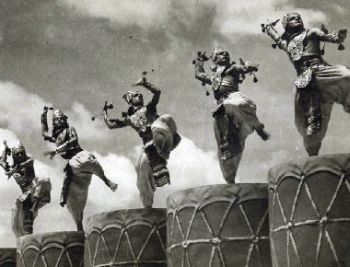
Set in a fairy-tale universe that can accommodate all sorts of kinky set designs, Chandralakha also has a climactic sword fight during which it becomes possible to determine that the villainous brother has an even fancier hairdo than Baba. Described along with the later Avaiyaar (1953) – also being recently shown in MOMA’s “Historical Retrospective of Indian Films” -– by producer-writer S.S. Vasan of Gemini Films, as one of the “pageants for our peasants,” this made-in-Madras costume drama makes for a pretty action-packed 186 minutes. All things considered, it belongs to the same childhood continuum as Lang’s late India-based movies, The Tiger of Eschnapur and The Indian Tomb.

AUGUST 11: At a press show where I’m reseeing two of Buster Keaton’s best shorts (Cops and The Electric House, both 1922) and one of his weakest features, directed by Herbert Blaché (The Saphead, 1920) – just one of the 14programs in the wonderful ongoing Keaton festival being presented at the Lincoln Plaza by Raymond Rohauer and New Yorker Films –- the fact that The Electric House and The Saphead [see photo below] have musical soundtracks while Cops doesn’t clarifies a central aspect of the purity of Keaton’s art.
Keaton’s moves, at their best –- in moments of pure physicality, movement, and concentration, as glued to their own secret private projects as characters are to tasks in the films of Robert Bresson – are visual music pure and simple, irreducible rhythmic and melodic inventions that are furnished by a polyrhythmic imagination. (If any proof of this needed, make haste to see The General, one of the finest examples, which is on through Saturday; alternately, check out either The Navigator or Seven Chances, both on next month.)It stands to reason, therefore, that any other music that’s used, even as “background,’ is bound to detract from this visual achievement -– bound to confuse, obscure, and otherwise distort the visual complexity.
The standard argument against hearing silent movies silently –- and it’s a good one -– is historical: most audiences in 1922 saw The Electric House with rinky-tink keyboard music, so why not today? A harder question to handle is whether the use of this music today merely perpetuates a bad habit. I’m speaking of Keaton now, not the silent cinema as a whole. But the issue is a crucial one, for it revolves around whether we believe sound is a means of anaesthetizing the senses or instructing them.
The frequently distracting music used with The Saphead (a movie that, one must admit, is very easy to get distracted from, for it mainly uses Buster as a well-dressed stick) — in which one block of musical material often overtakes and replaces another, as if someone were randomly twisting a radio dial — appears predicated on the assumption that listening is a passive, semiconscious activity. But in this case, and even more flagrantly in The Electric House, it can lull you into missing some of the greatest stuff that Keaton is actually doing up there on the screen, as director and performer. Setting in motion an escalator, a moving bathtub, sliding doors, a fully automated game of billiards, and a no less automated meal, mechanically-minded Buster, as character and as creator, builds rhythmic layers of complementary speeds and intensities – just one part of his perpetual dialogue and lovers’ quarrels with machines (like his romance with a runaway locomotive in The General) -– that the added music blithely smothers like a wet blanket. By contrast, the silentunreeling of the splendid Cops is a delight – a music whose exquisite rests are allowed to play over silence.
The comic treats in store at the Regency this week are an impressive lot: Harry Langdon, Harold Lloyd, and Fatty Arbuckle on Wednesday; Thursday through Saturday, a friendly 40s George Stevens flick about strangers meeting and becoming flatmates in Washington, D.C. – The More the Merrier – teamed with Preston Sturges’s demonically brilliant The Miracle of Morgan’s Creek (see below). Among the many recommendable highlights next month are three Billy Wilder double-bills, the Marx Brothers in Duck Soup and Horse Feathers, Jerry Lewis’s self-defining The Nutty Professor and The Disorderly Orderly (the latter directed by Frank Tashlin), Tati’s Trafic, and Clair’s A nous la liberté. But the “Directed for Comedy” series runs through mid-October, and these titles are merely a start.
One of the best things about the goofy, outrageous Miracle of Morgan’s Creek is Sturges’s baroque styling of the dialogue delivery. Officer Kockenlocker (William Demarest), a short, squat, and hilarious pug-nosed cop, barks a series of suspicious messages at quavering, dithering, Norman Rockwellish-small-town-nerd Norval Jones (Eddie Bracken), which go something like this: “There’s getting to be quite a little talk in this town….Where I come from we don’t skulk about the bushes, you get me?…When we gotta cross the street, we don’t crawl through the sewer to get there….When we got something to say, we say it!” Sturges, thus setting down his American, home-fried version of Dickens in precisely annotated musical terms (the preceding is punctuated by tortured chirps from Norval, “Oh…yes-sir…Y-y-es, sir…Yes, sir,” another set of improvised variations), is out and sailing.
Virtuoso jazz charts, Sturges scripts are scored for the instruments of individual voices. Norval and Trudy Kockenlocker’s impromptu, desperate wartime wedding with a querulous justice of the peace, much funnier than DeNiro’s monkeyshines with Liza Minnelli’s in New York, New York, is largely shaped around combinations of Norval’s manic stutter, the sadistic requirement that all difficult names be spelled out (a percussive idea) by him and Trudy (Betty Hutton) alike, and the fact that Norval’s fake name for the occasion happens to be none other than Ignatz Ratzkiwatski (which has a uniquely Sturgean music all its own). The results are as exciting, in a way, as hearing Dizzy and Bird play “Confirmation” in unison without stepping on any of the cracks. For Sturges, though, it’s just a stretch of everyday ensemble orchestration.
AUGUST 13:Advance reports on Honky Tonk Freeway, the only new movie I have to write about this week, led me to expect an utter disaster. What comes out instead is a surprisingly agreeable, offbeat mess – agreeably surprising, that is, if you go expecting a dull disaster. But go expecting a nonpretentious, non-urban fantasy farce of merging miniplots – a mobile Airport, a Nashville about the Florida interstate freeway, or a Citizen’s Band about a small resort town that desperately needs to become a freeway exit –and you probably won’t be halfway disappointed. It’s a foreigner’s appreciative vision of American life as a tacky yet surreal and legible comic strip, hatched out in part by Scottish coproducer Don Boyd and English director John Schlesinger.
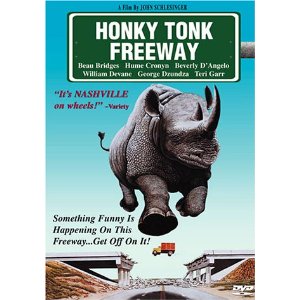
In a way, the whole movie evokes a sleazy roadside stand I once encountered in Florida (or perhaps dreamt I did), which advertised, “All the orange juice you can drink for a buck”: after one measly glass, I was told, “For a buck, that’s all you can drink.” On the debit side, William Devane, who was fine as the slimy villain of Hitchcock’s Family Plot, doesn’t convince me for a second here that he’s either a small town mayor or a Baptist minister. And the usually congenial Beau Bridges bores me with his strenuous efforts to seem normal. For my taste, Beverly D’Angelo and Teri Garr are more fun to watch.
For whatever it’s worth, the outsider’s democratic view of conspicuous consumption in this movie seems much more humane and politically palatable than the insider ‘s elitist view of S.O.B. If servants are stridently stereotyped in the Blake Edwards film, it’s a governor and other state officials who come off as impossibly overdone caricaturesin Honky Tonk Freeway – which gives you some idea of where this movie’s heart and head are: namely, in a more populist place that’s shared by the visions of Sturges and Tati.

As Marguerite Duras recently remarked [to me, during a visit to New York], Tati is the greatest living film director, “at least in a classical sense,” and it’s a pleasure to see his influence at work, even in a flimsy movie like this one. The social construction of the plot of Honky Tonk Freeway is strikingly akin to the overall dynamic conceptions of Playtime and Trafic (although execution, alas, is something else again). In Schlesinger’s version of social regrouping, a decentered, hero-less narrative of crisscrossed trajectories on the interstate (such as Geraldine Page and Deborah Rush as fellow nuns, Paul Jabara as a singing truckdriver, and Hume Cronyn and Jessica Tandy as a couple whose car is stolen) is set against a repeatedly recentered narrative about the klutzy town of Ticlaw, which paints itself pink, plants an elephant on water skis, and ultimately dynamites a bridge in order to catch the freeway flow.

In the closing sequence of Honky Tonk Freeway -– a multivehicular highway wreck with as many interlocking parts as a Rube Goldberg machine -– Trafic is virtually ransacked, in details ranging from a stray rolling wheel to a bowed member of the clergy examining a battered part. Schlesinger makes it fun to watch; but check out Tati’s original at the Regency about a month from now if you want to see the genuine brilliant article.

